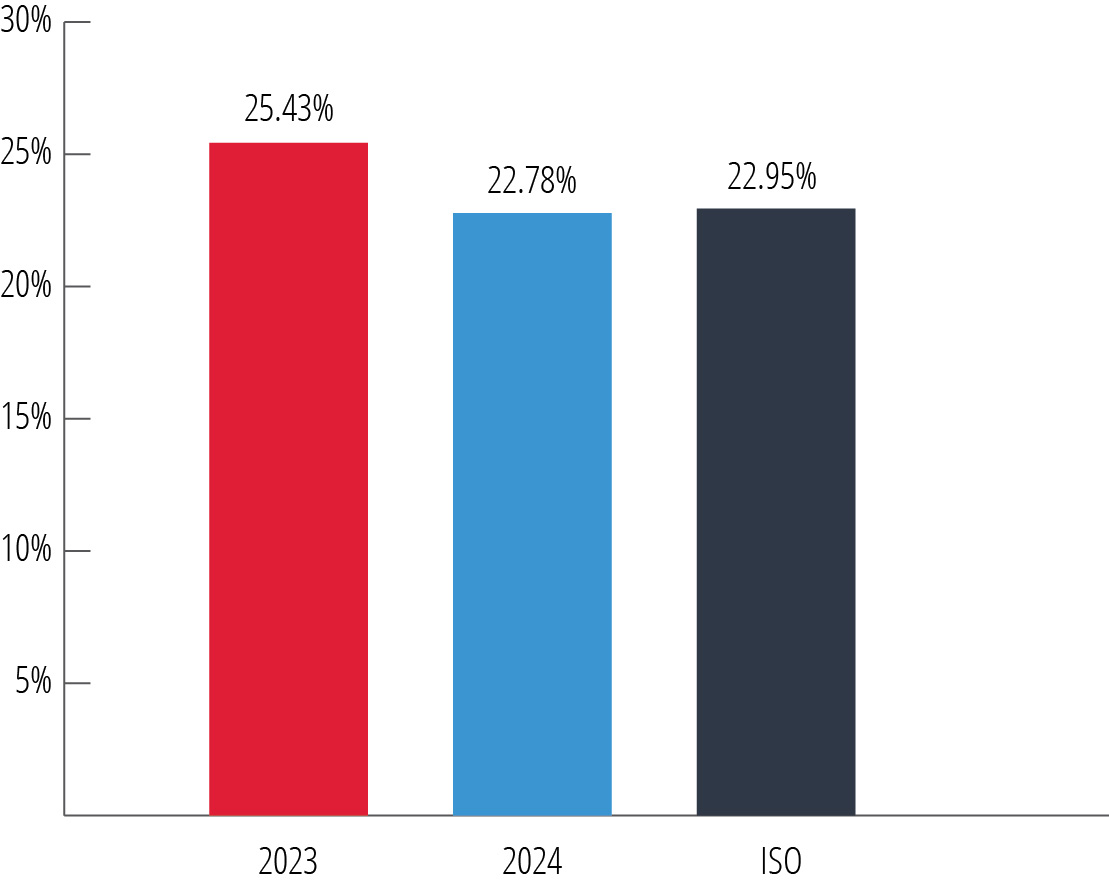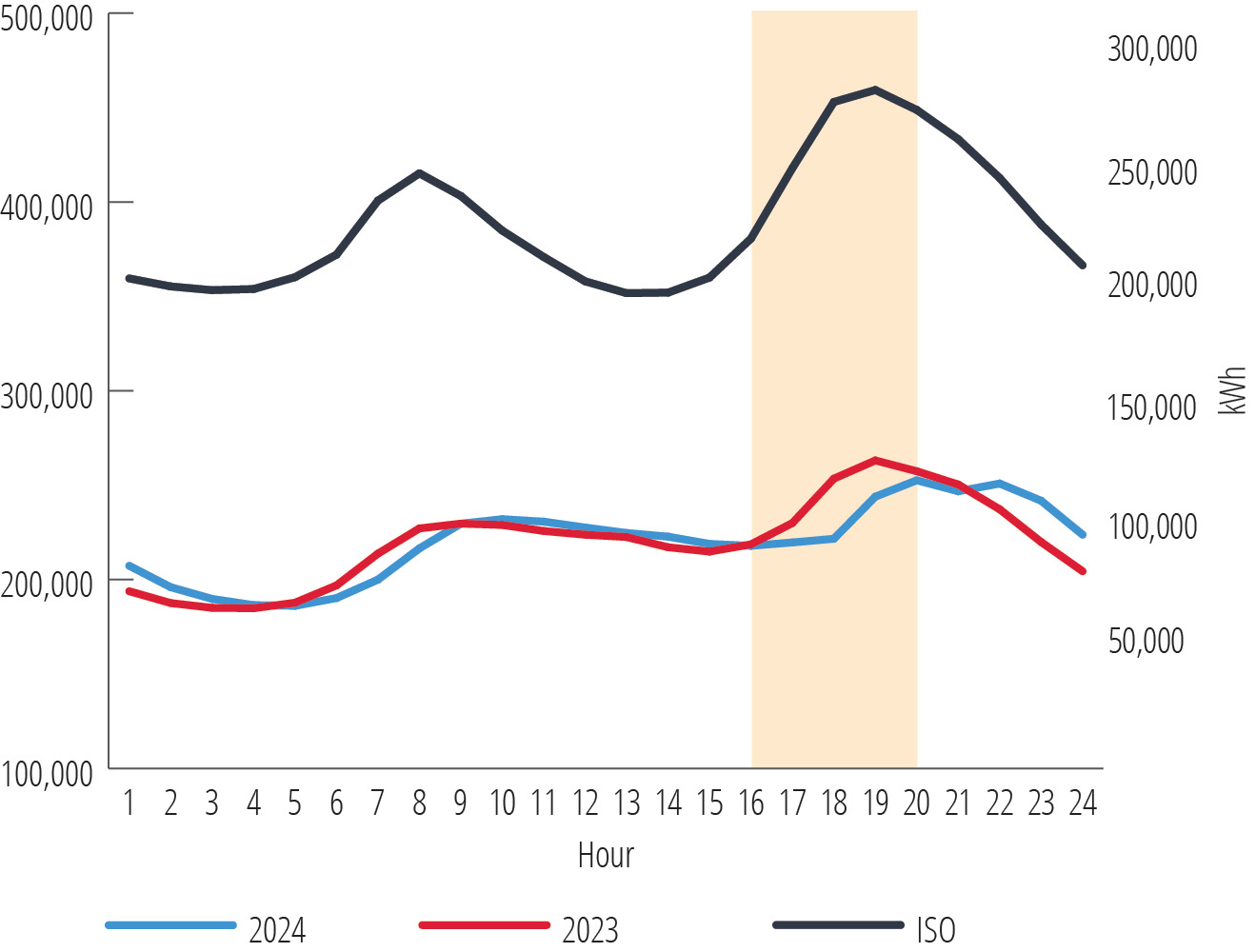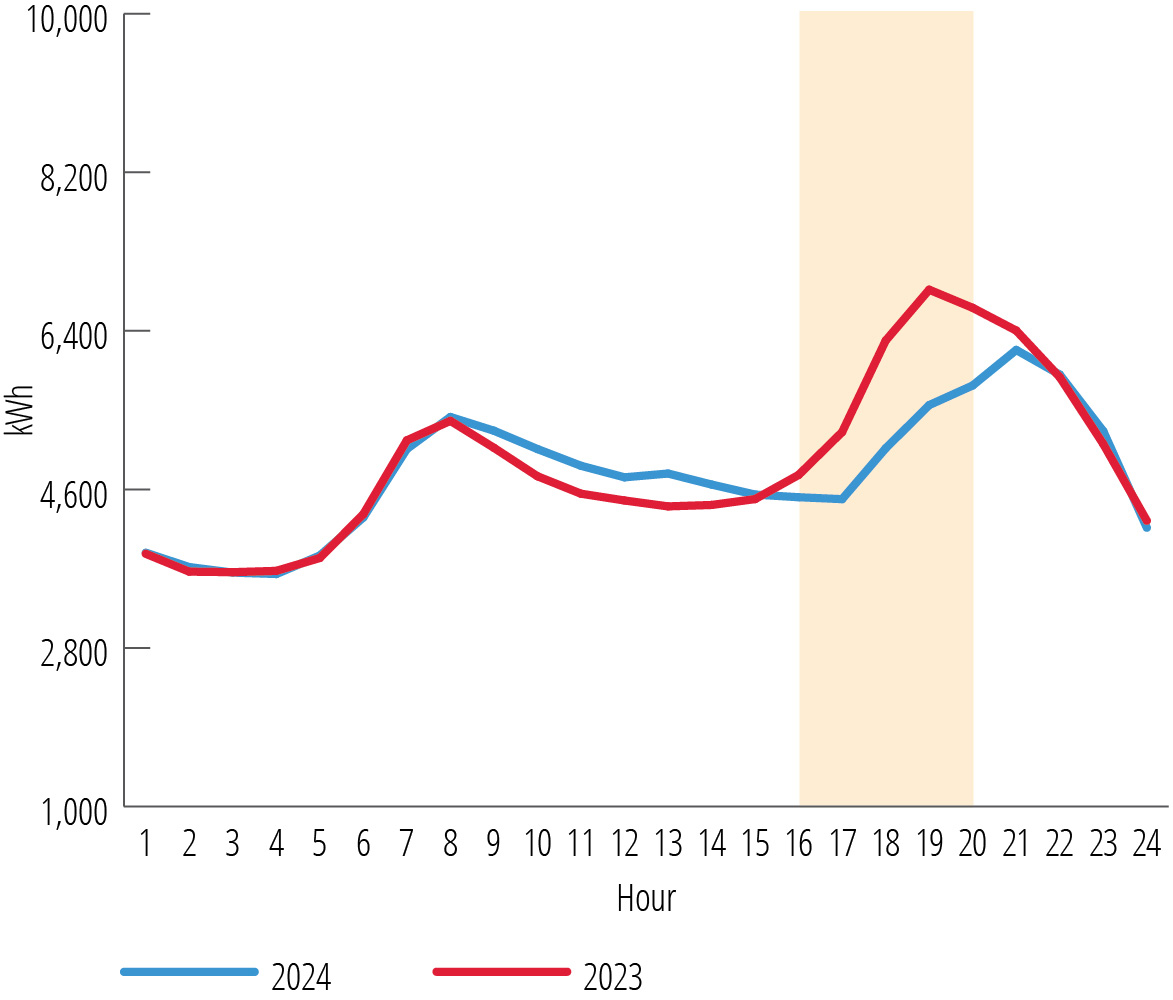by Kevin Kelly, Manager (retired), Groton Electric Light Department, Massachusetts
GELD’s mission statement is “to provide our customers with reliable power and excellent service at affordable prices.” In pursuit of that mission, GELD received a Gold Public Power Customer Satisfaction Award in 2023. Providing incentives to customers to change their electric use behavior and patterns lowers GELD’s costs and allows us to keep rates low into the future. A time-of-use (TOU) rate design perfectly aligns with its mission and performance.
| Groton Electric Light Department | Groton, MA |
| Employees | 14 |
| Customers Served | 5,601 |
| Customer Profile | 66% residential, 17% commercial |
| Annual Sales | 70,000 megawatt-hours |
| Annual Revenue | $12 million |
| Average Retail Rate | $0.171/kWh |
| Generating Mix |
Mix of ownership interests, purchase power agreements, and market purchases 42.2% nuclear, 31.2% natural gas, 11.4% hydroelectric, 6.9% solar, 5.0% wind |
| Governance | Board of three elected commissioners |
GELD transitioned to exclusive TOU rates for most of its residential rate class beginning in September 2023. This rate has a 20-hour off-peak period from 8:00 pm to 4:00 pm daily. GELD’s peak period is from 4:00 pm to 8:00 pm, which aligns with the period when almost all transmission and capacity costs have been determined over the last four years.
GELD’s TOU rate heavily depends on having an accurate advanced metering infrastructure (AMI) system. Without actual, accurate hourly data, it is not possible to consider TOU rates.
Almost all residential customers are participating in TOU rates, with consideration of applying TOU rates to the utility’s municipal and commercial customers.
The primary measure of success is the shift in the utility’s load curve. An analysis of the first winter with TOU rates revealed a bump in usage from 8:00-9:00 pm, with increased usage later into the evening as well as in the morning. GELD is cautiously optimistic that the more than 10% shift out of the peak hours in the winter will hold for the rest of the year. Based on GELD’s experience, a larger shift in the summer is expected. The utility predicts customers may have an easier time pre-cooling their home and living comfortably compared to preheating their home. There is also more air conditioning electric load than electric heating load among GELD customers. As a result, there are more opportunities to shift a high-usage device out of the peak hours during summer than in the winter.
GELD has helped educate customers through regular articles in its monthly newsletter, town social marketing sites, and town email lists.
A major factor for GELD’s success has been to communicate, communicate, communicate. Its three-year journey to TOU rates began with an initial small pilot. Then, GELD conducted a significant trial program with heavy communication in various media before implementing TOU rates with residential customers.
GELD expects that with more experience, the rate design will need to be adjusted. Specifically, the utility will need to constantly monitor when peaks are occurring, which may change the peak period time frames. There will also need to be ongoing analysis of costs to determine if the summer or winter multiplier between peak and off-peak rates needs to be adjusted.
The Need for a New Rate
| Rate Change | Implemented time-of-use rates for all residential customers |
| Goals | Reduce costs associated with peak demand; develop rate aligned with actual costs; incent customers to change behavior |
| Key results | More than 10% shift in demand out of peak hours; anticipated $300,000 savings in annual peak charges |
For 15 years, GELD collected hourly data on each residential customer and spent much of that time working on a wide variety of residential demand response programs. It was determined that real results would require customers to change demand behavior if GELD was to avoid substantial capital investments.
GELD NEEDED A NEW WAY TO LOOK AT RATES!
After multiple attempts at different residential demand response and peak reduction programs, it was determined that the true cost of the programs exceeded the documented savings that could be returned to participating customers. GELD defined a simple framework to drive the path forward.
That simple framework was:
- Understand what drives costs
- Develop an understandable program
- Demonstrate that it can work
- Keep it simple
- Implement it
The goal was to create a rate that provided customers with the incentive to modify their electric usage habits.
Pilot Rate and Shadow Billing
GELD worked with Boris Nikolic of RenwAI to develop a TOU rate that was both simple and captured the actual cost of service. The generation, transmission, and distribution costs were defined as:
- Generation and transmission costs: Set at 4 cents per kilowatt-hour (kWh) for 20 hours of the day and 40 cents per kWh for peak times (from 4:00 pm-8:00 pm).
- Distribution costs: Always set at 4.3 cents per kWh to cover GELD’s operating and capital costs.
In the summer of 2020, GELD introduced the initial 4/40 TOU pilot rate to 65 customers who embraced the program and shifted a substantial amount of their electric use out of the peak evening hours. GELD decided to expand the pilot to as many customers as possible for the summer of 2021. GELD partnered with a professor of economics from the University of Queensland who wrote an academic paper on GELD’s program results.
GELD delivered a “shadow bill” in addition to the customer’s regular bill. The customer’s standard bill read “please pay this bill,” while the shadow bill was for the customer’s information only, and showed customers how changing their behavior could change the dollar amount of their bill.
With the shadow bill program, customers were able to change their electric usage patterns and see the dollar effect of that change. Before the program, GELD’s average electric usage between 4:00-8:00 pm was consistent as a percentage of the utility’s daily usage.
Pilot Rate Results
Historically, in the summer, about 21% of GELD’s electric use was between the hours of 4:00 pm and 8:00 pm. A control group of customers was selected by the economist to provide a point of comparison when trying to determine the actual transmission and capacity savings generated by the TOU rate. With the shadow bill program, GELD saw a sizable drop in evening electric usage. Some customers reduced their electric use to a quarter of what it had previously been during peak hours.
Figure 1. Average Residential Hourly Electric Usage in Summer 2021

Figure 1 shows the average hourly use of the control group (1,001 customers) who were not in the TOU program and the real bill group (279 customers) who participated in the TOU program. The customers using the TOU rate had substantially lower evening usage than their peers. The reduction in evening usage translates into substantial savings in capacity and transmission costs. Another notable mention is the graph above reflects the amount of communication about pre-cooling homes that occurred in town, that the control group had a usage spike between 3:00-4:00 pm.
As a primarily residential utility, GELD historically peaked between 6:00-8:00 pm in the summer. Before beginning the TOU pilot programs, the peak was rarely between 3:00-4:00 pm. Recent history shows that over 40% of daily peaks were at the 19th hour (7:00 pm), and another 40% of daily peaks were at the 20th hour (8:00 pm). The highlighted areas in Figure 2 clearly show a measurable change in customer behavior to outside of the peak hours.
Figure 2. Substation Electric Load During 2021 Heatwave

Figure 2 shows GELD’s substation load during the three-day heatwave of 2021 that set the capacity hour for that year. The orange highlight number indicates the hour of the regional transmission peak, which determined GELD’s transmission and capacity payments.
In ISO-New England, transmission and capacity payments are determined by contribution to the regional peak. GELD’s costs are determined by the hour highlighted in orange, which is a full megawatt (MW) below its system peak. Figure 2 shows the 4/40 study group reduced and flattened their demand and GELD’s load at the substation from 4:00 pm to 8:00 pm. Most importantly, outside of this heatwave, the peak moved to the16th hour (4:00 pm) on a regular basis during the summer.
In New England, one MW of peak reduction is currently worth $154,350 based on the Regional Network Service charge, also known as a transmission charge. Going forward, ISO-NE has indicated there will be an increase of at least $10,000 per year in our RNS costs. One MW of generation capacity reduction is currently worth about $45,000, which is also expected to increase.
TOU Rate Implementation
After demonstrating the success of TOU rates to customers and the Board of Commissioners, the Groton Electric Light Department Board voted to retire the standard residential rate effective September 24, 2023.
The consultant who helped design the TOU rates created a tool to keep track of costs and expenses and assist GELD in creating rates into the future. GELD began saving all hourly customer data in 2020. Monthly generation and transmission costs were also collected. GELD overhead was spread evenly over 12 months.
Instead of hiring a consultant every six months in this rapidly changing world, historical data can be used to make models to analyze the potential impact of various rates. Using the RenwAI tool and making a few assumptions, GELD estimated net income from various rates. This tool, for a fraction of the cost of a typical rate consultant, can develop a rate design that works for any system.
Under current conditions, GELD sets rates with a small number of variables. Over the course of a year, the “summer” rate covers eight billing cycles between March 24 to November 24 and the winter rate covers four billing cycles between November 24 to March 24. For the summer rate, the peak rate generation charge is 10 times the off-peak rate, while the winter multiplier is seven times the off-peak rate. The current generation charge for the summer rate is 5 cents/kWh off peak and 50 cents/kWh on peak, while the winter generation rate is 7 cents/kWh off peak and 43 cents/kWh on peak. GELD offers an early pay discount of 1.7 cents/kWh, of which most customers take advantage. With the 4.3 cents/kWh distribution charge, the total summer rate is 7.6 cents/kWh off peak and 52.6 cents/kWh on peak. In the winter, the total rate is 9.6 cents/kWh off peak and 45.6 cents/kWh on peak.
GELD now has a path forward using a tool that allows rate changes as needed, ensuring costs are covered while incentivizing customers to change their behavior by moving their power demand out of peak hours to lower their monthly bill, creating a win-win dynamic.
TOU Rate Results
GELD is currently gathering data to compare 2023 under the flat electric rate to 2024 under the TOU rate to verify that the results are sustainable and beneficial to customers. Early indications are promising, and similar results should continue.
Figures 3 and 4 compare monthly data for the TOU rate (in blue) in 2024 to the same customers with the “old” flat residential rate (in red) used in 2023. The ISO data is the regional data for the same period for ISO-New England in 2024.
Figures 3 and 4 show the percentage of the customer’s electric load that is occurring during the peak hours on the peak day.
Figure 3. Percentage of customer load during peak hour of peak day in January

Figure 4. Percentage of customers load during the peak hour on peak day in March

Figure 5 shows the peak day in January 2024 compared to the peak day in January 2023. In 2024, it was significantly colder than 2023, which caused an increase in electric use across all off-peak hours while there is a reduction during the peak hours.
Figure 5. Total Hourly Electric Usage During January Peak Day

Figure 6 shows hourly totals for the entire month of February, and clearly shows a shift in electric use to later in the evening.
Figure 6. Total Hourly Electric Usage During February

Figure 7 compares hourly totals for the entire month of March, while Figure 8 shows the hourly totals for just the peak day in March.
Figure 7. Total Hourly Electric Usage During March

Figure 8. Total Hourly Electric Usage During March Peak Day

These figures clearly show a significant reduction in GELD’s electric usage during the peak hours. Up to 3% of customer demand has shifted from peak to off peak due to the rates. All peak reduction reduces both transmission and capacity costs. GELD’s total capacity and transmission costs are almost $3 million out of a $12 million annual budget. If these numbers hold for the remainder of the year, creating a rate structure that encourages customers to use electricity outside of the peak hours could lower transmission and capacity costs by about 10%, or $300,000 per year. There are also solid savings in generation costs, as generally the generation prices outside the peak period are lower than the peak generation costs for each day.
Conclusion
GELD is willing to share what it has done. The utility encourages others to jump into the world of TOU rates to help flatten the load and reduce the need for peak generation. If you would like additional information or a copy of the academic paper or the pilot rate results, please email Kevin Kelly, Jon Patterson, or Tammi Lemire or give us a call at 978-448-1150.



